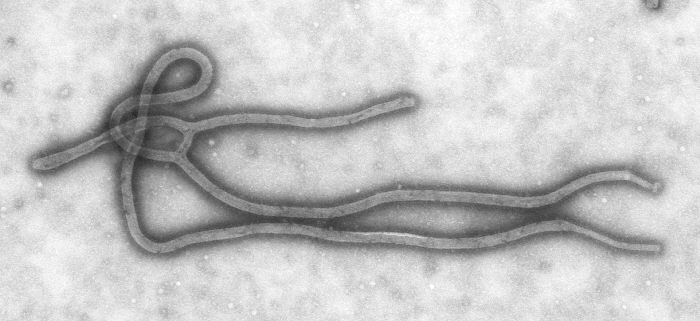Filoviridae
Filoviruses are viruses belonging to the family Filoviridae, which is in the order Mononegavirales. These viruses are single stranded negative sense RNA viruses that target primates. There are two genera: the Ebola virus (Ebolavirus, with four species) [1] and the Marburg virus (Marburgvirus).
These viruses cause horrific viral hemorrhagic fevers, characterized by bleeding and coagulation abnormalities including diffuse bleeding.
The virions (viral particles) are characteristically shaped as long, cylindrical, filamentous particles which may be straight, curved, coiled, or found in a "6" or "U" shaped configuration. They are occasionally branched and the particles vary greatly in length but the diameter (about 80nm) is consistent.
They are produced by budding from an infected cell, and consist of the viral RNA strand and proteins encapsulated in a lipid membrane formed from the host cell's plasma membrane.
The inability of the immune system to clear these viruses may, at least in part, be due to the complex synthesis of a viral glycoprotein which forms heterotrimeric spikes within the virions plasma membrane. The gene encoding this protein in Ebola virus, but not Marburg virus, contains a stop codon and as a result two forms of the Ebola GP can be produced via a frame shift during translation. The full length GP precursor then undergoes proteolytic cleavage to form GP while a truncated form of GP, secreted GP (sGP), is produced from the non-frame-shifted sequence. This results in a variety of epitopes which may result in a less focused immune response that simply doesn't have the time to clear the infection before the organism succumbs. Another virally expressed protein recognised by the immune system is VP40 which is normally expressed on the membrane complexed to VP24.

The filoviridae family was discovered in 1967 when 31 people were infected with the Marburg virus in Marburg, Germany after working with tissue from monkeys imported from Uganda [1]. Seven people who caught the disease died. All subsequent outbreaks have occurred in sub-Saharan Africa. The second genus of the filoviridae family, Ebola virus, was discovered in 1976 when outbreaks occurred in northern Zaire and southern Sudan. The Ebola virus is a very potent virus, having a mortality rate of 50% up to 90% reported in some of the Zaire outbreaks.
The natural reservoir of both the Marburg virus and the Ebola virus appears to be zoonotic, which means that the virus is transmitted to humans from other animals. Despite numerous attempts to find the source of both the Marburg and Ebola viruses, neither has been found. Bats though because they can replacate filoviriade-like viruses have been suspected [2].
The mechanisms through which filoviruses spread are not fully understood. The route of transmission from animals to humans is unknown. Person-to-person transmission occurs primarily through physical contact with infected bodily fluids.
References
- ↑ Martini, GA, Knauff, HG, Schmidt, HA et al. A previously unknown infectious disease contracted from monkeys: Marburg virus disease. Deutsche Medizinische Wochenschrift 1968; 93(12):559–571.
cs:Filovirus
de:Filoviridae
nl:Filovirussen
Template:WikiDoc Sources